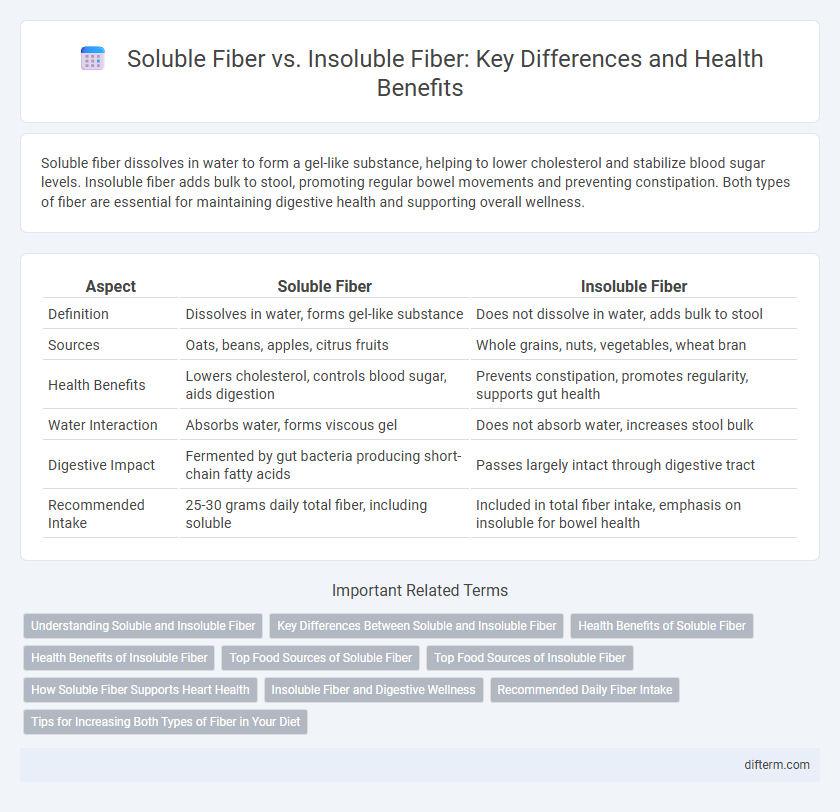Soluble fiber dissolves in water to form a gel-like substance, helping to lower cholesterol and stabilize blood sugar levels. Insoluble fiber adds bulk to stool, promoting regular bowel movements and preventing constipation. Both types of fiber are essential for maintaining digestive health and supporting overall wellness.
Table of Comparison
| Aspect | Soluble Fiber | Insoluble Fiber |
|---|---|---|
| Definition | Dissolves in water, forms gel-like substance | Does not dissolve in water, adds bulk to stool |
| Sources | Oats, beans, apples, citrus fruits | Whole grains, nuts, vegetables, wheat bran |
| Health Benefits | Lowers cholesterol, controls blood sugar, aids digestion | Prevents constipation, promotes regularity, supports gut health |
| Water Interaction | Absorbs water, forms viscous gel | Does not absorb water, increases stool bulk |
| Digestive Impact | Fermented by gut bacteria producing short-chain fatty acids | Passes largely intact through digestive tract |
| Recommended Intake | 25-30 grams daily total fiber, including soluble | Included in total fiber intake, emphasis on insoluble for bowel health |
Understanding Soluble and Insoluble Fiber
Soluble fiber dissolves in water forming a gel-like substance that helps lower blood cholesterol and regulate blood sugar levels, making it essential for heart health and diabetes management. Insoluble fiber, found in whole grains and vegetables, adds bulk to stool and promotes regular bowel movements, reducing the risk of constipation and colorectal cancer. Both types of fiber contribute to digestive health, but their distinct properties support different physiological functions important for overall well-being.
Key Differences Between Soluble and Insoluble Fiber
Soluble fiber dissolves in water to form a gel-like substance that helps lower blood cholesterol and regulate blood sugar levels, while insoluble fiber adds bulk to stool and promotes regular bowel movements by speeding up intestinal transit. Soluble fiber is commonly found in oats, beans, and fruits, whereas insoluble fiber is abundant in whole grains, nuts, and vegetables. Both types of fiber play essential roles in digestive health, but their distinct functions target different aspects of gastrointestinal and metabolic well-being.
Health Benefits of Soluble Fiber
Soluble fiber dissolves in water, forming a gel-like substance that helps lower blood cholesterol and stabilize blood sugar levels. It promotes heart health by reducing LDL cholesterol and supports digestive health through improved nutrient absorption and regular bowel movements. Sources rich in soluble fiber include oats, barley, beans, and fruits such as apples and oranges.
Health Benefits of Insoluble Fiber
Insoluble fiber promotes digestive health by adding bulk to stool and accelerating intestinal transit, which helps prevent constipation and reduces the risk of colorectal cancer. It supports weight management by enhancing satiety and regulating blood sugar levels, contributing to overall metabolic health. Additionally, insoluble fiber aids in maintaining a healthy gut microbiome by providing a favorable environment for beneficial bacteria.
Top Food Sources of Soluble Fiber
Oats, barley, and legumes are top food sources rich in soluble fiber, which helps lower cholesterol and stabilize blood sugar levels. Fruits such as apples, citrus fruits, and berries also provide high amounts of soluble fiber, promoting gut health by feeding beneficial bacteria. Including vegetables like carrots and Brussels sprouts further enhances dietary soluble fiber intake, supporting overall cardiovascular and digestive wellness.
Top Food Sources of Insoluble Fiber
Top food sources of insoluble fiber include whole grains such as wheat bran, brown rice, and barley, which promote digestive health by adding bulk to stool. Vegetables like carrots, cucumbers, and celery also provide significant amounts of insoluble fiber, supporting regular bowel movements and preventing constipation. Nuts and seeds, particularly almonds and flaxseeds, contribute to insoluble fiber intake, enhancing gut motility and overall digestive function.
How Soluble Fiber Supports Heart Health
Soluble fiber helps lower blood cholesterol levels by binding to bile acids and promoting their excretion, reducing the risk of heart disease. It also improves blood sugar control, which can prevent the development of type 2 diabetes, a major risk factor for cardiovascular problems. Foods rich in soluble fiber include oats, barley, fruits, and legumes, all of which contribute to maintaining healthy arteries and reducing inflammation.
Insoluble Fiber and Digestive Wellness
Insoluble fiber, found in foods like whole grains, nuts, and vegetables, plays a crucial role in digestive wellness by adding bulk to stool and promoting regular bowel movements. This type of fiber helps prevent constipation and supports a healthy gut microbiome by enhancing intestinal transit. Consuming adequate insoluble fiber is essential for maintaining colon health and reducing the risk of digestive disorders such as diverticulitis and hemorrhoids.
Recommended Daily Fiber Intake
The recommended daily fiber intake for adults is 25 grams for women and 38 grams for men, with a balance of soluble and insoluble fiber promoting optimal digestive health. Soluble fiber, found in oats, beans, and fruits, helps lower cholesterol and regulate blood sugar, while insoluble fiber, present in whole grains and vegetables, aids in bowel regularity and prevents constipation. Consuming a variety of fiber-rich foods ensures adequate intake of both types for improved gut function and reduced risk of chronic diseases.
Tips for Increasing Both Types of Fiber in Your Diet
Incorporate a variety of fruits, vegetables, whole grains, and legumes to boost both soluble and insoluble fiber intake efficiently. Soluble fiber, found in oats, beans, and apples, aids digestion and helps regulate blood sugar, while insoluble fiber in whole wheat, nuts, and leafy greens promotes bowel regularity. Gradually increase fiber consumption and drink plenty of water to minimize digestive discomfort and maximize health benefits.
Soluble fiber vs Insoluble fiber Infographic

 difterm.com
difterm.com